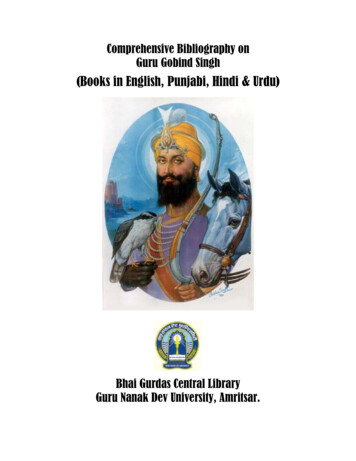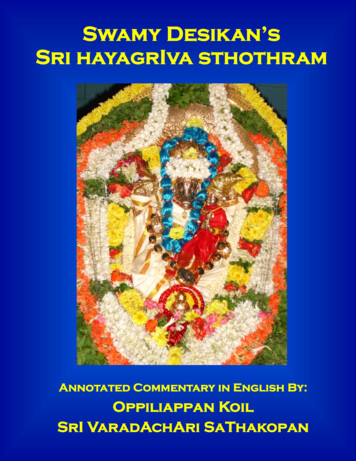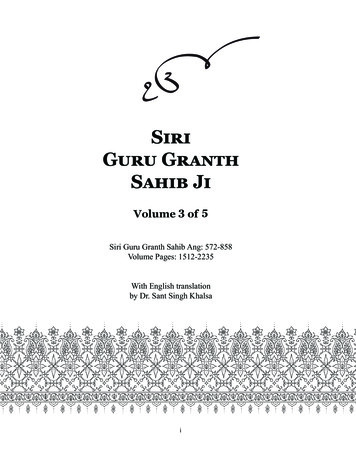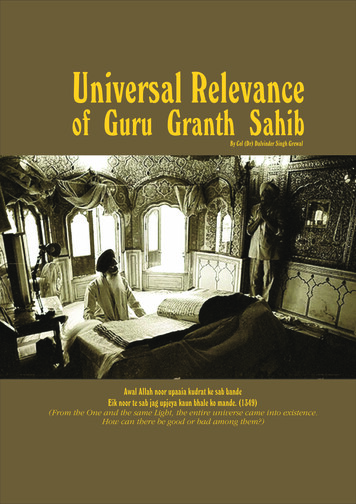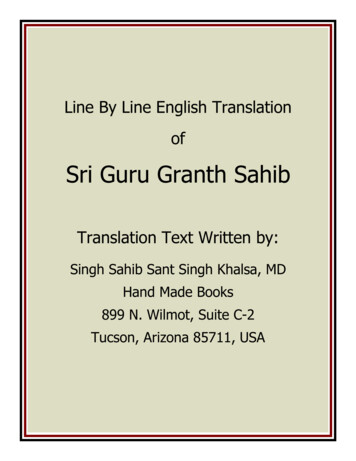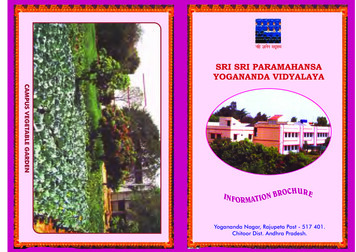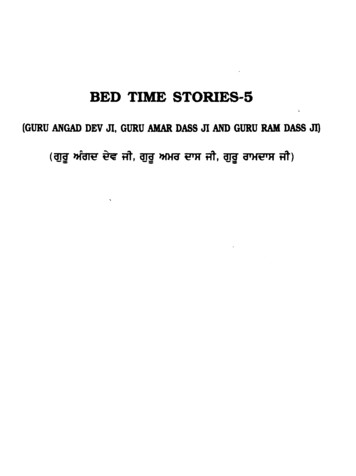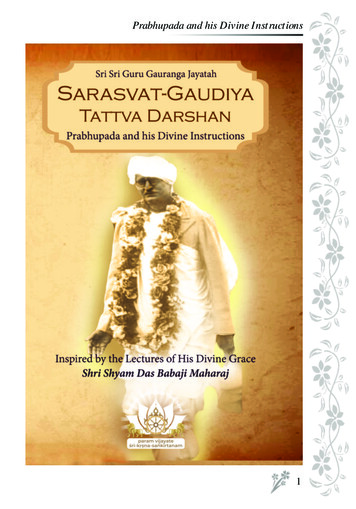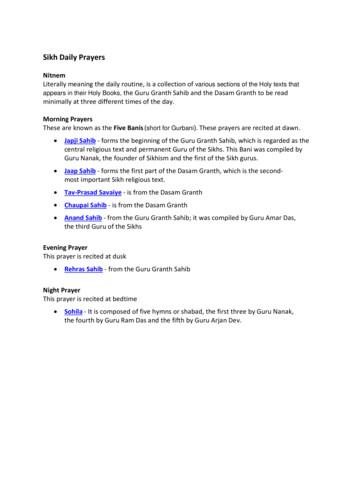
Transcription
From Guru Nanak to Guru Granth SahibBy Sawan Singh GogiaIntroductionThis book contains brief life stories and teachings of the ten Masters (Sikh Gurus) and Sri GuruGranth Sahib, The Eternal Guru. At the end of each chapter multi-choice questions with theiranswers are given to hold the attention of the young readers. At the end of the book, objectivetype questions covering the whole book are also given so that the reader may test his/herknowledge.It is sad that our young generation in general and those born or brought up outside thePunjab, in particular, have very little knowledge of their religion and its golden heritage. Most ofthem play outside the Gurdwaras if and when they visit the Gurdwara as Gurdwara services(conducted in Punjabi) which they scarcely understand are not understood by them and they feelbored. If the present state of affairs continues, our children may not only forget the teachings ofthe great Gurus, but also their names and number. That will be a sad day, indeed.Our young generation is not wholly to be blamed for this. We parents neither talk to themin Punjabi nor tell them anything about our religion. We fail to provide them with suitablereligious literature. Sunday schools of small duration in our Gurdwaras are doing a good job, butthey cannot make up for the loss because of numerous distractions our children have during theweek.Science may throw light on physical world, but it is only the teachings of great saintsand sages which offer a glimpse of the spiritual world and act as a guide in character building. Letus not forget that a Gurdwara building is not the heart ant soul of our religion. The soul is in theWord and teachings of the Gurus. Our fine Gurdwaras will only be monuments of our folly and inthe not too far future they would be empty if we fail to persuade our younger generation tocontinue the tradition and uphold principles of the Sikh teachings.The Sikh Gurus, through their examples, challenged superstitions, tyranny and bigotry.Their life story is a beacon light which inspires all who seek guidance in order to proceed on thepath of truth. There is no dearth of books about the lives of the Sikh Gurus, written in English, forthe young readers, but most of these books don’t attract them. They narrate a few incidents fromthe lives of the Gurus in the form of stories. Some of these stories come from traditionalbiographies called ‘Janam Sakhis.’ A few of such stories stretch the credulity of the modernmind. Therefore, most of these books have failed to attract the young generation. Moreover, abiography does not mean only narration of a few incidents in the shape of stories.In this book, I have tried to lay more stress on those stories from the lives of the Gurusand their teachings which appeal to the young generation. Pertinent hymns translated in simpleEnglish have been added. Multi-choice questions with their answers have been given at the end ofeach chapter and again at the end of the book to hold the attention of the young readers. Effortshave been made to minimize the mention of places and persons strange to these readers, andunnecessary details have been avoided in order to maintain their interest.It is hoped that these significant incidents from the lives of the Sikh Gurus that illustratetheir teachings also would be easily understood and grasped by the readers. I am confident thatmy labor of love will bear fruit and this book will generate, in the young minds, love andreverence for the Gurus and their teachings. I am sure it will show them a way of life which shallbeckon to them like a lighthouse in the years to come.I am grateful to Dr. Hakam Singh who encouraged me to write the book and edited it. Mysincere thanks are due to the Sikh Welfare Foundation of North America for getting it publishedand bringing it to the young readers. I am highly thankful to the organizers of the Sikh Center ofOrange Country, Santa Ana (CA) for allowing me the unrestricted use of their excellent library. I
appreciate the service rendered by my young grandson, Shawnbir Singh Gogia, who typed the faircopy of the manuscript. I am thankful to him.In the end I bow my head to Waheguru for giving me strength and inspiration to writethis book. I pray for my health so that I may do some more useful service. I am aware of my shortcomings and limited knowledge. I would welcome suggestions and criticism, and try to improve.Sawan Singh,Principal(Retd)Phone # (916) 967-37574230 Winding Woods Way,Fair Oaks, 95628(CA)THE FIRST MASTER GURU NANAK DEV (1469 – 1539)Birth and childhood:Guru Nanak Dev , the first Guru of the Sikhs and the founder of the Sikh religion was born in1469 (CE), more than 500 years ago, in a village named Talwandi, about 50 miles west ofLahore, the capital of the West Punjab, now in Pakistan. A beautiful Gurdwara called ‘JanamAsthan’ or Sacred Birth Place, stands at the place of his birth. Later , this village came to becalled Nankana Sahib in memory of Guru Nanak Dev. His father, Mehta Kalu, was anaccountant of Rai Bular, the Muslim Chief of Talwandi. Nanak had a sister named Nanaki, fiveyears older than Nanak. Even as a child, Nanak was exceptionally thoughtful and intelligent.He was a child of smiles. He often gathered his friends under the shade of a tree and sangwith them in praise of God. He had a melodious voice. He liked simple food and simple dress.He loved the poor and helped them. Nanak, even as a child, gave the signs of Nanak the saintand Guru. His sister Nanaki and Rai Bular, the ruler of the place, were the first to recognizethis fact.Schooling:Nanak was sent to the village priest to learn Hindi and Arithmetic. He learned to read andwrite soon as if he had known it already. He was a quick learner. His teacher remarked that hewas an extraordinary child beyond his age. Once Nanak asked his teacher to teach him aboutthe Creator. Nanak also talked about good and evil. The teacher was amazed and said “Nanak,you are my teacher. I have learnt a lot from you.” Now Nanak was sent to a Muslim teacher tolearn Persian. There, too, he learnt in a short time all that the teacher could teach him. Whenhe discussed about God and real education, the teacher was astonished and bowed beforeNanak.The Sacred -thread Ceremony:Like baptismal ceremony in Christians and Barmitzvah in Jews, every Hindu child must beinvested with the sacred - thread ‘Jeneu’ ceremony . The family priest, in the presence of therelatives, puts the sacred –thread around the boy’s neck. Nanak’s father also wanted him toget initiated. When the priest asked nine years old Nanak to wear the sacred thread, Nanaksaid to him, “What is the use of this thread?” The priest replied, “It protects the wearer. EveryHindu must wear it.” Nanak said, “I would like to wear a thread that does not burn or getsoiled. Virtues of compassion, self-discipline, patience and truth make the real sacred- thread.I shall wear the sacred- thread that stands for the pure life.” On hearing these truthful words,the priest and those gathering realized the hollowness of rituals. A sacred hymn, on thesubject, Uttered by Guru Nanak is a part of the ‘Asa Dee Vaar’, in Guru Granth Sahib at page471.Marriage:
Nanak’s parents decided that he should marry. They thought that married life would make himinterested in worldly affairs. He was married at the age of fourteen to Sulakhni, daughter of amerchant at Batala, Distt Gurdaspur (Punjab.) Even after marriage, Nanak showed no interestin family affairs. His heart was in meditation and his thoughts were other worldly.Keeper of the State Stores:Jai Ram, the husband of Bibi Nanaki, heard the complaints of his father-in-law against Nanak.He invited Nanak to Sultanpur, a famous city, where he got him the position of a store keeperfor the storehouse of Dault Khan Lodhi, the Governor of Sultanpur in 1490. Mata Sulakhni alsojoined Nanak at Sultanpur. In due course, two sons were born to them-Siri Chand in 1494 andLakhmi Chand in 1497.Nanak performed his duties honestly to the satisfaction of all. He wasvery popular and kind to the poor whom he gave rations free. Some wicked people werejealous of Nanak. They complained against him to the Governor who got the accounts of thestore audited. Everything was found to be alright and the Governor was satisfied. However,Nanak quit his job.Neither Hindu nor a Muslim:While staying at Sultanpur, Nanak went, as his daily routine, to a nearby river for bathing.One day, when he did not return, people feared that he had been drowned. In reality, he hadfocused his mind on God and sung songs in His praises in a nearby forest. He got into a stateof trance and stayed, in that state for three days. When people saw him coming to Sultanpur,they were overjoyed and gathered around him. It happened around the year 1500. GuruNanak gave his first formal sermon on that day, when he said, “For God there is no Hindu andno Muslim; all of us are His children, equal human beings.” Now he was not Nanak, but GuruNanak Dev.Prayer at the Mosque:The Guru was called by the Governor to give an explanation of his words. When he met theGovernor, the Qazi (The Muslim Clergyman) asked the Guru what he meant by his utterance.The Guru explained to him the qualities of a true Musalman and true meaning of his prayers. Asacred hymn uttered by the Guru on the subject is there in Guru Granth Sahib at page 141.The Qazi was astonished to hear such candid words. He invited the Guru to offer prayer(Namaz) with them in the mosque. The Guru accompanied them, but stood watching whileeveryone said his prayers. After the prayer, the Qazi said angrily, “Why did you not join us?”The Guru replied, “While praying, you were worried about the safety of your new-born colt andthe chief was busy buying horses in Kabul; with whom was I to offer prayer?” Both the Qaziand the chief admitted that their mind had been wandering during the prayer. Thus the Gurutaught everybody that true prayer is single minded devotion to God.Extensive Journeys to Reform Mankind:On hearing the Guru’s reply, the Governor fell at the Guru’s feet and remarked that God wasspeaking through the Guru’s mouth. He offered the Guru an estate and requested him to staywith him to teach him how to become a true worshipper of God. Guru Nanak Dev was in noneed of temporal possessions and replied, “The Creator wants me to go to distant lands todeliver God’s message,” the Guru was distressed to see the followers of one faith hating thefollowers of the other faith. A large section of the Hindu society was considered low-caste oruntouchables and treated worse than animals. In the Indian society, superstitions prevailedand women were treated as inferior human beings. Rulers were bigots and corrupt. They didnot care for the welfare of their subjects. Idol worship was prevalent among the Hindus. Anascetic was regarded superior to even a disciplined householder. Guru Nanak Dev undertookfour extensive journeys (Udasis) which covered a substantial portion of the Indian subcontinent. He also visited Ceylon, Tibet, Mecca (Saudi Arabia), Baghdad (Iraq), Iran,Afghanistan and many other places. He was thirty one years old at the time he undertook hisfirst journey. He took (Bhai) Mardana his rebeck player and devoted follower with him.
Bhai Lalo and Malik Bagho:On their way, they stayed with a carpenter, named Bhai Lalo, at the city of Eminabad. Inthose days, carpenters were treated as low-caste Hindus. The local village official, MalikBagho, was a corrupt officer. He invited the Guru to a feast at his house, but the Guru refusedto accept any food from him. Bagho was surprised as well as angry, and asked the reason forthe refusal. The Guru replied, “Your food consisting tasty and sweet dishes is, in fact, madefrom the blood of the poor. You are cruel, haughty and greedy. Others work for you and youtake a lion’s share of what they produce. What you take is full of their blood. Bhai Lalo earnshis living honesty by working hard. His food tastes good like milk.” Bhago was embarrassed bythe bold and frank comments of the Guru who also spoke against the caste system. Bhagocould not deny the allegations and confessed his guilt. He requested to be forgiven andpromised to live an honest life in future. The Guru said to the people gathered there, “Alldishonest earnings are the blood of the innocent. Honest earnings are like sweet milk andmake the mind pious.” There is no hymn in Marauliffe’s book.Sajjan, the Robber:During one of their journeys Guru Nanak Dev and Mardana stayed for the night with a person,named Sajjan, which means a friend. He had constructed an inn for travelers. But, in fact, hewas a wicked man. He killed people staying at his inn for their possessions. In the evening,the Guru sang a sacred hymn while Mardana played on his rebeck. The song flowed from theGuru as soft loving light from the moon. The hymn meant that outward show of good actionsmeans nothing if a person is evil at heart. Our good deeds are our true friends (Sajjans) andhelp us not only in this world but also after death. Evil actions make our mind dirty and lead tosufferings in this world as well as in the next world. This hymn is given in Guru Granth Sahibat page 729. Sajjan was overwhelmed with remorse on hearing this divine hymn uttered bythe Guru. He realized his mistakes, confessed his misdeeds, repented, cried and promised tolead an honest life. He said to the Guru; “Save me, O’ Divine One!” “Be pure,” said the Guru,“sing His praises.”At Hardwar:Hardwar is a city on the bank of the river Ganges. It is a center for Hindu pilgrimage. Whenthe Guru visited this place, he saw people offering water towards the rising sun, while theybathed in the river. He asked one of the pilgrims, “What are you doing?” The pilgrim replied,“We are offering water to our dead ancestors living in heaven,” The Guru stood among themand began throwing water with both his hands towards the opposite direction. People askedhim what he meant by that foolish act. “I am watering my farm at Kartarpur (Punjab),” saidthe Guru. People laughed and said, “You are a fool. Do you think that the water would reachover two hundred miles to your farms?” The Guru replied, “If the water I am throwing cannotreach the distance of two hundred miles, how do you expect that your handful of water willget all the way to your dead ancestors in the heavens?” The people started thinking over thismeaningful reply given by the Guru and could not find a logical argument to challenge him.Thus, Guru Nanak, in a dramatic way, taught people that hollow rituals don’t have anyreligious value. We can’t send anything to our dead ancestors. We should love, respect andcare for them when they are alive. Those people realized the subtle meaning of Guru’s wordsand became the Guru’s follower.Guru Nanak and Duni Chand:A very rich man, Duni Chand, lived at Lahore, the capital of what is now West Punjab inPakistan. When Guru Nanak Dev reached Lahore, Duni Chand was giving (Saradh) a big feastwhich the Hindus offer to the Brahmans, the priests, in memory of their ancestors. Theybelieve that what ever they give to the priests on that day reaches their dead forefathers inthe next world. Duni Chand invited Guru Nanak Dev, too. Seeing the priests being fed, theGuru asked Duni Chand what was going on. He replied that he was performing his father’s‘Saradh’ ceremony. The Guru said, “ I cannot carry food to your dead father so I don’t like tolet your food go waste. I shall appreciate if you do me a favor instead. Here is a sewing
needle. Keep it with you. I would like you to give my needle back to me in the next world.”Duni Chand did not understand the Guru and said, “How can I carry this needle with me whenI die?” “If a priest can carry enough food, clothes and money for your dead father, I wonderwhy this small needle is too big for you to carry;” replied the Guru. The idea went home toDuni Chand. He asked for the Guru’s advice. The Guru advised him and all others presentthere, “Work hard, and share your earnings with the needy. Remember God because it is theprayer that will help your dead parents.” The Guru sang a sacred hymn which meant: - Workhard and share your earnings with others. Thus you will find way to the God’s grace. Thishymn is given in Guru Granth Sahib at page 468. The Guru’s dramatic advice showed manypeople the hollowness of rituals. Duni Chand understood the Guru’s advice. He gave up hisprincely life, distributed his wealth among the poor, started working with his own hands andshared his earnings with the needy. Duni Chand and his wife along with others became theGuru’s followers.Guru Nanak Dev at Jagannath:Jagannath (Lord of the World) is the name of a famous temple at Puri (Jagan Nath a town) atthe coast of the Bay of Bengal. At that temple, every evening, the idol of lord Vishnu who isone of the three supreme deities of the Hindus is worshipped by the priests in an imposing butartificial way. Every priest holds in his hand a salver studded with pearls containing many littlelamps of ‘Ghee’ (purified butter), offerings, flowers and incense; and sing hymns to the lordVishnu. All stand up to offer it to the god. Everyone has a fan made of feathers of peacock andfans the enshrined god. When Guru Nanak Dev visited the temple, the head priests invitedhim for the worship (Arati) and began the ceremony. The Guru did not participate. After theceremony, the priests were very angry with him for his disrespectful behavior. Now he raisedhis eyes to the heaven and sang the famous hymn in God’s praise. It is there in Guru GranthSahib at page 13. The first line of it if translated will mean : - The sun and the moon, O’ Lord,are thy lamps; the sky, thy salver; the orbs of the stars, the pearls encased in it. Guru NanakDev did not like hollow ritualistic worship. Expanse of the sky, the sun and the moon, theprocession of the stars, the natural incense of the sandal, the winds and forests were thefitting accessories of the Guru’s purer worship of the God of creation.A Visit to Mountain Sumer and Mansrower Lake:After visiting Kashmir, the Guru came to mountain Sumer and Mansrower lake. There he metmany renowned hermits (Yogies) living in caves. They were surprised to see him there andasked him about his creed. “My creed is that of love for God and His creatures,” replied theGuru. Then, they asked him, “How are things going on in the world below?” The Guru replied,“The darkness of falsehood prevails throughout. You have deserted the poor people and thusneglected your duty towards mankind. Don’t get lost in your efforts to attain salvation only foryourself. Help others on that path too.” The hermits tried their best to convince the Guru inarguments that their path of renunciation of the world was superior but failed. They asked himto perform a miracle. The Guru replied, “I don’t believe in miracles. I rely on nothing but God.”The hermits were silenced and their pride was humbled. The talks that the Guru had withthem were afterwards versified by him in his composition ‘Sidh Goshat’ witch is included inGuru Granth Sahib from page 938-946.Visit to Mecca:Mecca is the holiest place of the Muslims. It is located in Arabia. Muslims from every part ofthe world come to Mecca for pilgrimage called ‘Haj’. When Guru Nanak Dev along withMardana reached there, he was very tired. He lay down to rest and fell asleep with his feettowards the holy shrine called the ‘Kaaba’. Muslims consider ‘Kaaba’ as the House of God andpray in the direction of ‘Kaaba’ from all over the world. For them, it is sinful to stretch onesfeet towards it. When one of the caretakers of the shrine saw the Guru thus asleep, he flewinto rage and said, “Why are you sleeping with your feet towards the House of God?” Manypeople gathered and began shouting at the Guru who replied, “Brother, tell me the directionwhere God is not there.” These words of the Guru opened their eyes. In this dramatic way, hetaught the people of Macca that God is in all direction and in all places and beings. They asked
him, “who was superior, the Hindu or the Muslim?” The Guru replied, “Without good actionsboth will suffer. It is the deeds and not religion that make a man superior.”Journey to Baghdad. (Iraq)In due course of time, Guru Nanak Dev reached Baghdad. When the priest of Baghdad met theenthusiastic stranger, the Guru, he (the priest) inquired who he was and what sect hebelonged to. The Guru said, “I have appeared in this age to show man kind the way to reality.I reject all sects and know only one God whom I recognize. He pervades on the earth, theheavens and in all the nether regions.” The Guru further added, “There are hundred ofthousands of worlds beyond our own, above as well as below. Their number is difficult tocomprehend.” As this doctrine is contrary to what is written in the holy ‘Koran’, the priest didnot agree at first, but was convinced later on by forceful arguments of the Guru. It is also theopinion of the modern scientists. It seems that the Guru’s way of preaching was logical andscientific. The Guru also expressed this idea in pauri 22 of Jap Ji.A Haughty Fakir Humbled:On his way back to the Punjab, Guru Nanak Dev stopped at the foot of a hill in the westernpart of the Punjab. On the top of the hill, there lived a Muslim Fakir, called Vali Qandhari, theprophet of Qandhar (a city in Afghanistan). As Mardana was very thirsty, the Guru asked himto go up and drink water from the fountain of Vali Qandhari. Mardana went up and appealed tohim, in the name of God, for water. Vali Qandhari was very egoistic and paid no heed to theappeal of Mardana when he found that Mardana was the follower of the Guru. Mardanareturned disappointed. On being urged by the Guru, Mardana again went back to repeat hisrequest humbly, but it was of no avail. When Mardana was dying of thirst, the Guru said,“Never mind, Mardana! Dig here; there is a fountain of water flowing at your feet.” When thestone was lifted, a stream of clean water began to flow. Now water in Vali Qandhari’s springstarted depleting. He was very angry and pushed a large rock towards the Guru who raised hishand. The rock touched the Guru’s hand and stopped. A print of the Guru’s hand is still thereon the rock. There is a beautiful Gurdwara called ‘Panja Sahib’ (the holy print). It is nearIslamabad, the capital of Pakistan and the city is also named Panja Sahib. Every year in April,this day is celebrated there and devotees from all over the world come to pay their homage.Vali Quandhari whose pride was humbled came down and bowed at the Guru’s feat. His heartand mind were purified. The Guru said to him, “Live as a lover of God should live and be kindto all.”Guru Nanak and Emperor Babar:Towards the end of their journey, Guru Nanak and Mardana again visited Eminabad. Babar,the Mughal king of Afghanistan invaded the Punjab as he wanted to rule India. At that time,the Punjab was being ruled by cruel and corrupt rulers of the Lodhi dynasty of the Pathans.Babar carried fire and sword through the Punjab and his army played havoc with the people ofEminabad who resisted him. Many innocent people were also arrested and massacred. GuruNanak and Mardana were also arrested. In the prison, the Guru sang a heart-soothing hymnwhich made the prisoners forget their fear and sorrow. They sat with folded hands andlistened to the Guru’s holy song. Babar’s men saw this and informed him. Babar, himself,visited the prison and saw the Guru sitting with closed eyes and singing with a sweet voice.Babar did not understand the song and asked the Guru what he was singing. The Guru replied,“I am calling upon God to see what you have done to these innocent people. Why is Hewatching your cruelty and the plight of innocent victims as a passive observer?” This holyhymn of Guru Nanak is there in Guru Granth Sahib at page 360. Guru Nanak Dev’s frank andbold words touched Barbar’s heart. He fell at the Guru’s feet and declared that God appearedin his (the Guru’s) face. He felt ashamed and sorry for what he had done. He requested theGuru, “What can I do for you, O’ holy man?” The Guru said, “I need nothing for myself. Set allthe prisoners free and return their property to them. You must be a just and kind ruler if youwant to rule India.” Babar agreed to follow the Guru’s advice.
At Kartarpur:Having accomplished his mission after completing extensive journeys in about two decades, in1520 Guru Nanak Dev resolved to return to his own country. He founded a city namedKartarpur after the name of Kartar, the Creator, on the right bank of the river Ravi. He settledthere living like an ordinary householder. He wanted to show the people that he did notcondone the path of an ascetic for salvation. He was over sixty, but he did not sit idle. Hewould get up early in the morning, take bath and sing sacred hymns. At daybreak, peoplegathered around him and listened to his talk on religion. His whole day was spent working inthe fields. In the evening, Sodar and the Sohila (evening prayers) were chanted. Everybodytook food from the common kitchen. In due course of time, Kartarpur became a center ofreligious preaching. His followers belonged to every caste and creed. Guru Nanak Dev followedthis routine till September 22, 1539 when he bypassed his own two sons, named Angad, hismost sincere and devoted follower, as his successor; placed the umbrella of spiritualsovereignty over his (Angad’s) head, bowed to him, and passed away. A famous saying inPunjabi goes as follows:- “Nanak Shah Fakir, Hindu Da Guru, Musalman Da Pir.” It meansGuru Nanak Dev was a saintly person whom both, the Hindus and the Muslims, claimed astheir own religious leader.Teachings:Guru Nanak Dev taught us that there is only one God, free from the bondage of birth anddeath. He is omnipresent and omnipotent. We should always remember God. Repetition of HisName is cure for all ailments. God is not to be degraded by making images of Him andworshipping them. To be one with God is the aim of life and to attain this goal one must shedego. When ego goes, the way to the lord opens. Conquest of the self is the conquest of theuniverse. All men are equal in the eyes of God. No one is high or low by virtue of his caste,color or creed. There is no need to shun the world. Abide pure amidst the impurities of theworld just as a lotus lives in water. This can be done by leading an honest life doing onesduties to the best of ones ability. Earn your own living by honest work and share it with otherswho are less fortunate. Hard earned money is like honey. Wealth collected through unfairmeans makes the mind dirty. To take away what belongs to others is like eating the forbiddenflesh of cow (for the Hindus) and of the swine (for the Muslims). Truth is high but higher still istruthful living. Dedicate yourself to service in the world. We should accept God’s decisionwithout any grudge. Vain are the pilgrimages and prayers if one does not accept His Will. Thegood or bad that men do, they themselves reap fruit thereof.Contributions:Guru Nanak Dev brought a social and religious change by providing a platform, Sangat andPangat, where all could pray, meet and eat together without any discrimination. His preachingwas a great step towards arousing consciousness of a common nationality. He approved allworldly pursuits, but not at the cost of righteousness and truth. He pointed out that there wasbut one God, the Primal and Omnipresent. The Guru established a separate religion and laidout a simple and easy way of obtaining salvation by the repetition of God’s Name and singingHis praises. He appointed his successor purely on merit before his death and thus saved hisfollowers from being dispersed. He created a distinct and self-conscious community whichplayed a fruitful and glorious role in his country’s history. He travelled thousands of miles tospread his message to reform mankind for two decades. He raised his voice against the cruelrulers of his time and in favor of their victims. He pleaded the cause of females for equalrights. A hymn to this effect, uttered by the Guru, is in Guru Granth Sahib at page 473. . TheGuru also uttered hymns condemning the superstitions and hollow rituals observed at the timeof birth and death in the Hindu family. Guru Nanak Dev composed 947 hymns which areincluded in Guru Granth Sahib. Jap Ji is considered his masterpiece and is to be recited by hisfollowers daily in the morning.Questions
Questions1. Who was the founder of Sikhism?A) Guru Arjan Dev.B) Guru Nanak Dev.C) Guru Gobind Singh.2. What was the name of his father?A) Bhagat Kabir.B) Bhai Jetha.C) Metha Kalu.3. WhatA) MataB) MataC) Matawas the name of his mother?Tripta.Jeeto.Bhago.4. What was the name of his sister?A) Mata Sulakhani.B) Baibe Nanki.C) Bibi Bhani.5. Name the town where he was born?A) Amritsar.B) Lahore.C) Talwandi.6. What is the present name of that town?A) Nankana Sahib.B) Anandpur Sahib.C) Amritsar.7. In which country is that town located?A) Arabia.B) Afghanistan.C) Pakistan.8. In which year was Guru Nanak Dev born?A) 1464.B) 1469.C) 14799. How many sons did the Guru have?A) two.B) three.C) four.10. Mark one who was not the Guru’s son.A)Sri ChandB)Mool ChandC)Lakhmi Chand11. Where did the Guru’s sister live after marriage?A)KartarpurB)SultanpurC)Nurpur12. Who wrote Jap Ji Sahib?A)Guru Nanak Dev
B)Guru Angad DevC)Guru Arjan Dev13. How many journeys did Guru Nanak Dev undertake?A)threeB)fourC)six14. Why did the Guru undertake those journeys?A) For sight seeingB)In search of GodC)To reform mankind15. Did Guru Nanak Dev preach renouncing the world?A)noB)yesC)only in old age16. Who was Guru Nanak Dev’s companion during his journeys?A)Bhai BalaB)Bhai MardanaC)none17. Did Guru Nanak Dev go out of India?A)yesB)noC)yes, only up to Ceylon18. Did the Guru believe in wearing the sacred-thread?A)yesB)noC)yes, only in old age19. What does the story of ‘True Bargain’ teach us?A) the Guru was a spend thriftB) he wanted to
The Guru explained to him the qualities of a true Musalman and true meaning of his prayers. A sacred hymn uttered by the Guru on the subject is there in Guru Granth Sahib at page 141. The Qazi was astonished to hear such candid words. He invited the Guru

